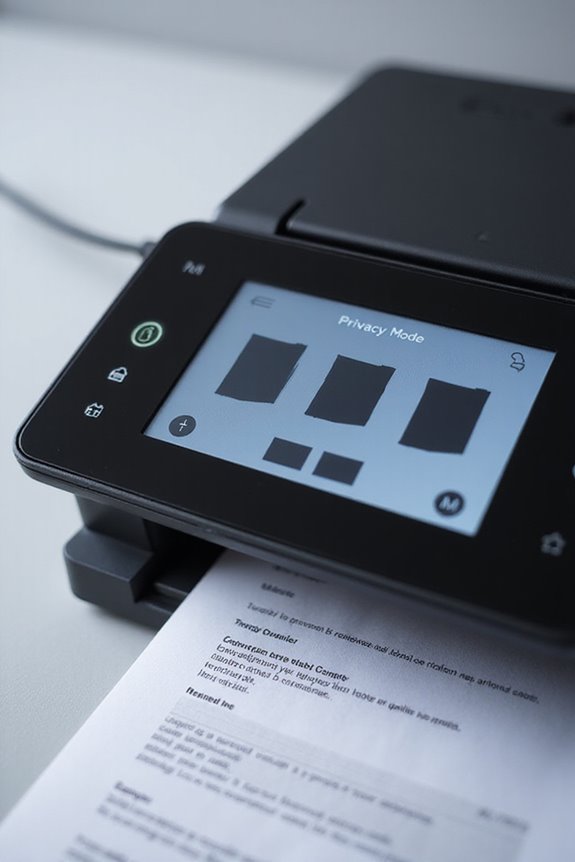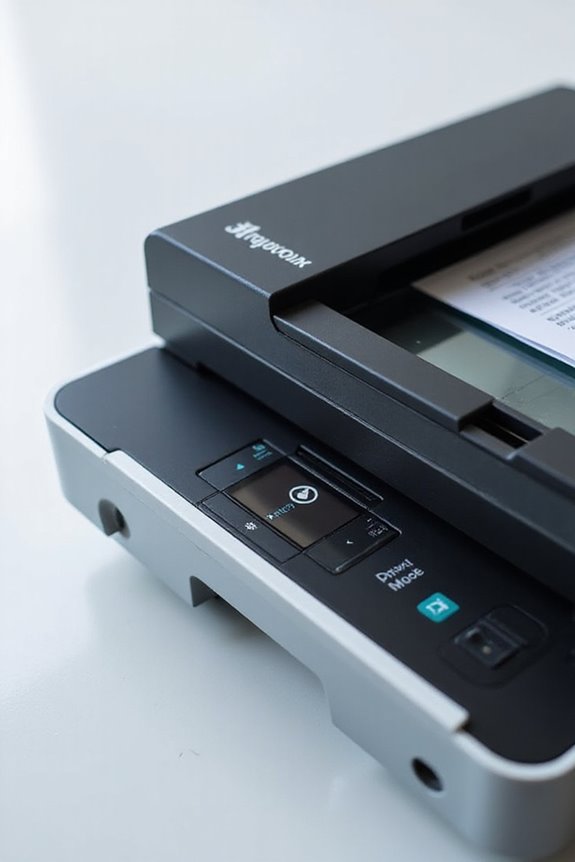To use scanner privacy protection features, we should activate encryption technologies to protect sensitive documents. We can also set user permissions, limiting access to essential information, thereby enhancing security. Utilizing audit trails allows us to monitor access and modifications effectively, keeping compliance with regulations like GDPR. With these measures in place, we can guarantee our data remains secure. The standout features provide robust protection, and there’s much more we can explore to enhance our privacy strategies.
Key Takeaways
- Implement encryption technology to protect documents by encoding them, ensuring both symmetric and asymmetric methods are utilized based on your needs.
- Set user permissions to control access to sensitive information, allowing only authorized individuals to view or modify critical documents.
- Monitor data flow visibility to maintain compliance with regulations like GDPR, ensuring transparency in how data is handled.
- Use audit trails to track access and modifications to sensitive health information, providing accountability and oversight within your organization.
- Regularly update privacy policies and conduct privacy risk assessments to identify vulnerabilities and ensure ongoing compliance with relevant regulations.
Understanding Scanner Privacy Protection Features
When we consider scanner privacy protection features, it’s essential to understand how they contribute to data security and compliance. Scanners equipped with encryption technology safeguard our documents by encoding them, ensuring access remains restricted. They support various methods, like symmetric and asymmetric encryption, adapting to emerging threats. Properly adjusting our scanner settings can limit user permissions, controlling who accesses sensitive information. Additionally, features that maintain visibility into data flow help us track where personal data ends up, keeping us compliant with regulations like GDPR. By utilizing automated tools within these devices, we’re better protected against unauthorized sharing and can manage our data efficiently. It’s all about enhancing our control over sensitive information while ensuring robust data protection. Incorporating features like audit trails ensures we can monitor access and modifications to sensitive health information effectively.
Implementing Automatic File Labeling

Implementing automatic file labeling can considerably enhance our file management processes, especially in environments where data security is paramount. By utilizing default labeling, we can streamline the process of categorizing files without the need for in-depth content analysis. To get started, we’ll switch off content-based labeling and select a custom default label. Enabling the “Relabel files” and “Enforce default label” options lets us override existing labels seamlessly. This approach simplifies bulk classification in repositories, ensuring immediate consistency. Plus, if we need to reset our labeling strategy, we can remove all existing labels simply by setting the default label to “None” and activating the same enforcement options. This functionality supports efficient and secure data management. Additionally, incorporating strong security features, such as triple-layer security, can further protect sensitive data during the labeling process.
Managing Data Visibility and Inventory

In today’s data-driven landscape, managing data visibility and inventory effectively is crucial for maintaining compliance and security. We should centralize all our data sources in a unified data inventory to create a single source of truth. Including both structured and unstructured data guarantees extensive coverage. With our scan settings configured correctly, we can automate updates to this inventory, capturing new and modified data assets. By prioritizing critical data types, we align our efforts with compliance requirements. It’s also essential to register each data source before scanning, utilizing tailored parameters like frequency and scope. By employing authentication mechanisms suited to our data landscape, we enhance the security of our scanning operations and ultimately improve our oversight of sensitive information. Additionally, implementing Triple Layer Security ensures that sensitive data is protected during the scanning process.
Conducting Privacy Risk Discovery

Conducting privacy risk discovery is vital for organizations looking to safeguard sensitive information while meeting compliance requirements. We start by defining our scope and objectives, which means pinpointing data sources and regulatory mandates. Selecting the right privacy scan types, like full, differential, and assessment scans, is essential. These offer an extensive understanding of sensitive data and compliance gaps. Utilizing risk assessment techniques such as automated AI scanning enables us to continuously identify risks with accuracy. Additionally, we can employ labeling scans to classify data by sensitivity, improving control. By combining these strategies, we enhance our ability to mitigate potential privacy violations effectively. Furthermore, understanding OCR technology can improve document management and enhance the overall privacy of sensitive information. Remember, ongoing monitoring keeps us ahead of emerging risks.
Establishing Governance Controls

Establishing effective governance controls is essential for guaranteeing our privacy strategies align with legal requirements and organizational goals. We need to define clear privacy policies that adhere to regulations like GDPR and CCPA. By implementing standardized workflows, we can prioritize and streamline our privacy risk alerts during software development. Assigning accountability roles within our development and security teams guarantees we maintain governance accountability. Additionally, we should document our data inventory procedures to know how personal data is collected, stored, and shared. Continuous monitoring of our compliance posture through automated scans helps us track adherence to these policies. This proactive approach not only enhances our privacy policy alignment but also minimizes risks associated with non-compliance in our organization. Regular maintenance with cleaning cards can also help ensure the longevity and effectiveness of our scanning devices, further supporting our privacy initiatives.
Integrating Scanners With Development Tools
Integrating scanners with our development tools is a game-changer for enhancing security during the software development lifecycle. By leveraging scanner compatibility with CI/CD pipelines, we can automate security checks, reducing vulnerabilities before they reach production. Tools like GitHub Actions allow for seamless tool integration, using SARIF for standardized reporting. This helps guarantee consistent monitoring. Additionally, support for multiple programming languages means that scanners like Detekt for Kotlin and Soblow for Phoenix can be easily included in our workflows. Utilizing output formats like JSON facilitates centralized reporting, giving us clear visibility into detected vulnerabilities. Overall, automated scanning can greatly improve our security posture, making it an essential practice in our development environments. Furthermore, integrating with cloud storage services enhances document management and collaboration across teams.
Ensuring Security for Document Scanners
When we think about document scanners, guaranteeing their security is essential for protecting sensitive information. One significant aspect is implementing secure encryption, like AES with at least 256-bit keys, for documents during scanning and storage. This keeps data confidential and reduces interception risks. We should also encrypt transmission networks using TLS protocols and consider utilizing VPNs for secure remote access to our devices.
User authentication is another key factor. Enforcing strong passwords, multi-factor authentication (MFA), and role-based access controls helps limit who can access sensitive documents. Regular monitoring of logs and periodic access reviews guarantees our security measures stay effective. By prioritizing these practices, we can safeguard our document scanners against potential threats and enhance our overall data protection.
Utilizing Web Privacy Scanners
Utilizing web privacy scanners can greatly boost our security posture, especially as threats continue to evolve. Different scanner types like network-based and agent-based options allow us to identify vulnerabilities across our systems. Network-based scanners focus on perimeter weaknesses, while agent-based ones operate locally, sending results to a central server. Cloud-based scanners offer scalability without needing local installations. Automated scanning schedules guarantee consistent vulnerability assessments, and real-time monitoring allows us to respond quickly to emerging threats. We should combine these scans for thorough coverage and frequently update their databases. Using application-specific scanners can pinpoint weaknesses in specific software, ultimately helping us maintain a robust security environment while streamlining our vulnerability assessment process.
Leveraging Reports for Compliance Auditing
After addressing vulnerabilities with web privacy scanners, we can enhance our security measures by focusing on compliance auditing through detailed reporting. These compliance reports help us identify unauthorized tracking activities and evaluate our practices against laws like GDPR and CCPA. By analyzing compliance metrics, we receive measurable scores that indicate our risk levels, such as high or medium compliance risk. In addition, audit findings outline specific violations and suggest practical solutions to boost our privacy protection. We can map data flows, assess our consent management mechanisms, and develop corrective action plans. With this information, we can confidently demonstrate our commitment to compliance and protect customer trust while remaining prepared for regulatory inspections.
Frequently Asked Questions
How Can I Customize Alerts for Specific Privacy Violations?
When we think about customizing alerts for specific privacy violations, we should explore alert settings, defining violation types we want to track. This thoughtful approach helps us better protect our data and streamline our responses.
What Training Is Recommended for Staff Using Privacy Scanners?
When it comes to privacy training, we believe mandatory sessions keep our staff engaged and informed. Regular training guarantees we all understand regulations and can protect sensitive data effectively, creating a culture of privacy awareness together.
Can Privacy Scanners Integrate With Existing Compliance Software?
Think of our privacy landscape as a complex garden. By employing integration strategies with compliance software, we reap substantial compliance benefits, ensuring our data blooms safely while safeguarding our organization against potential risks and violations.
What Are the Costs Associated With Implementing Privacy Scanners?
When considering the implementation costs of privacy scanners, we need to conduct a thorough cost analysis. Budget considerations include initial setup fees, licensing, support, and potential add-ons. Planning diligently helps avoid unexpected expenses down the line.
How Often Should Privacy Scanning Be Conducted for Compliance?
When it comes to privacy audit frequency, we should conduct scans at least quarterly for compliance risk assessment. Adjusting our schedule based on data sensitivity and changes in our environment helps guarantee ongoing protection and adherence.





